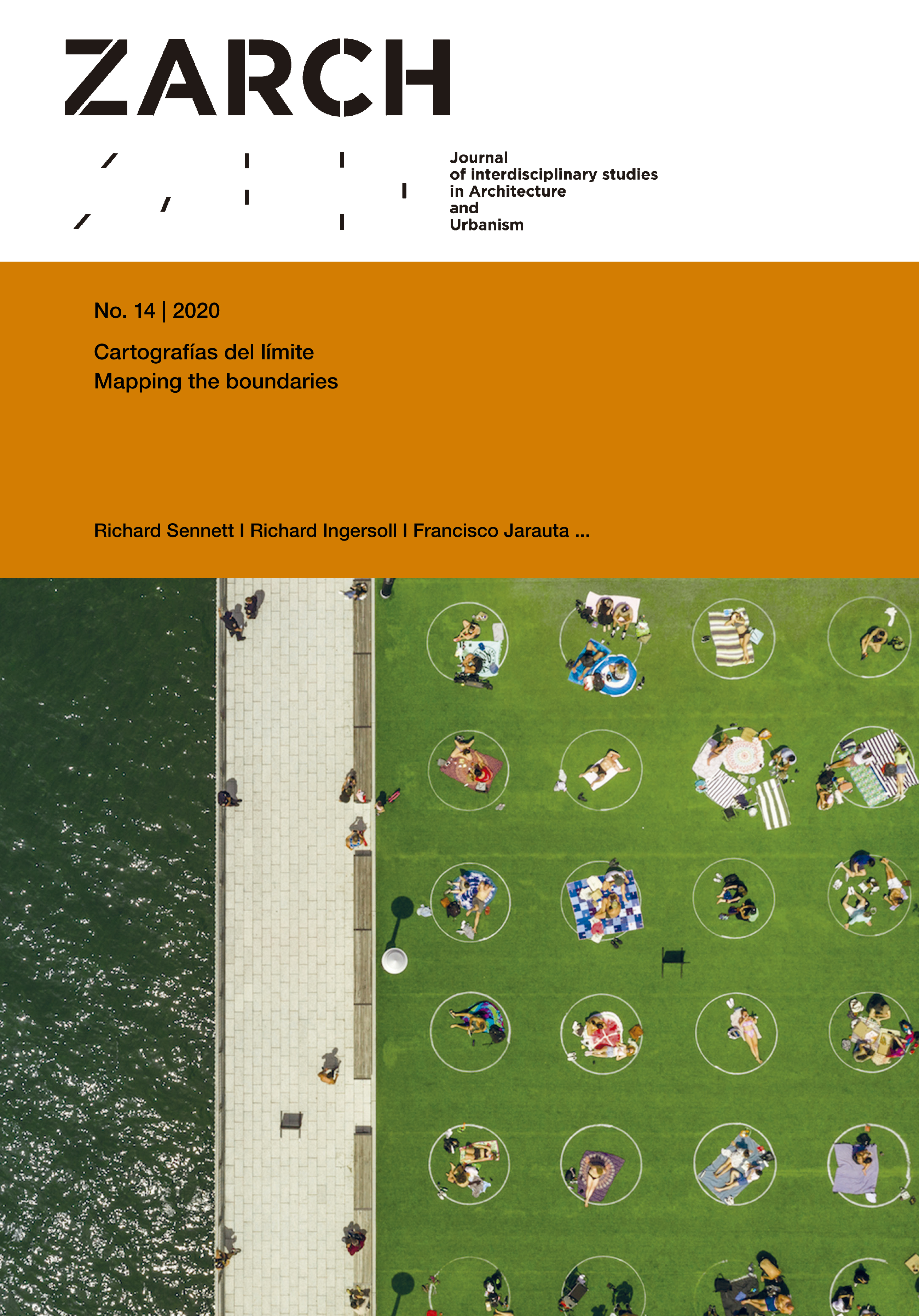Urban integration or persistent enclaves?
Transformations in the perimeter of four housing estates in Zaragoza
DOI:
https://doi.org/10.26754/ojs_zarch/zarch.2020144443Keywords:
Cartographic comparative analysis, Ordinary peripheries, Borders, Barriers, Boundaries, SeamsAbstract
This work is part of a broader investigation on the housing estates built between the fifties and seventies of the 20th century in Spain. The perimeter turns out to be an essential element in them, as they are shaped as unitary formal fragments determined by a well-defined geometry. This paper analyzes, from the perspective of urban space, how the perimeter of these relatively autonomous pieces –unitary operations characterized by the repetition of isolated blocks in open planning over free spaces– has evolved. A perimeter that it is also in contact with a quite different urban fabric, that of the so-called 'ordinary peripheries' –gradual growths that adopt traditional systems based on streets and blocks– that were configured around the housing estates in the same period. The objective is to study the transformations that have occurred in the perimeter space of four housing estates located in Zaragoza, comparing, through graphic analysis, the situation at the time of its construction with the current state. Starting from a broad theoretical framework, this analysis aims to relate the various urban situations generated during these more than fifty years with concepts explored by different authors, such as limit, barrier, edge or seam. The result allows evaluating how, in some cases, the dissolution of the perimeter of these housing estates has favored processes of relative urban integration, while in others, its consolidation has contributed to the persistence of the initial status of enclave.
Downloads
References
Adiego, Elvira, José Antonio Baguena, José Luis Calvo, Enrique Grillo, Carlos Guelbenzu, Victor Guelvenzu, José Félez, María José Moreno, y Ana Taboada. 1984. Zaragoza: Barrio a Barrio. Editado por Federación de Asociaciones de Vecinos. Zaragoza: Cometa S.A.
Agencia de Ecologia Urbana de Barcelona. 2008. Plan Especial de Indicadores de Sostenibilidad Ambiental de la Actividad Urbanística de Sevilla. Barcelona.
Alexander, Christopher, Sara Ishikawa, Murray Silverstein, Max Jacobson, Ingrid Fiksdahl-King, y Shlomo Angel. 1977. A Pattern Language: Towns, Buildings, Construction. Nueva York: Oxford University Press.
Bakema, Jaap. 1966. From chair to city-a story about people and space. En Jaap Bakema and the open society, editado por Dirk van den Heuvel, 114-21. Amsterdam: Archis Publisher.
Cervero Sánchez, Noelia. 2017. Las huellas de la vivienda protegida en Zaragoza, 1939-1959. Editado por Rolde de Estudios Aragoneses. Zaragoza: INO Reproducciones.
Colquhoun, Alan. 1978. Arquitectura moderna y cambio histórico. Ensayos 1962-1976. Barcelona: Gustavo Gili.
Deleuze, Gilles, y Félix Guattari. 1987. A Thousand Plateaus: Capitalism and Schizophrenia. Minneapolis: University of Minnesota Press.
Díez Medina, Carmen, y Javier Monclús. 2020. Ciudad de bloques. Madrid: Abada.
Díez Medina, Carmen, Javier Monclús, Isabel Ezquerra, y Sergio García-Pérez. 2018. Superblocks, neighbourhood units and residential islands as fragments of the collage city. Housing estates in Italy and Spain in the 1960s. En The 18th IPHS Conference. Looking at the World History of Planning. Yokohama, 741-50. TU Delft. https://doi.org/10.7480/iphs.2018.1.2724.
Ezquerra, Isabel, Javier Monclús, y Carmen Díez Medina. 2018. Polígonos de vivienda frente a periferias ordinarias en Zaragoza. Exploraciones cartográficas sobre la adaptabilidad de las formas urbanas». En II Congreso Internacional ISUF-H. Ciudad y formas urbanas. Perspectivas transversales. Volumen 8. Formas urbanas y mapping, 45-56.
Gehl, Jan. 2006. La humanización del espacio urbano: la vida social entre los edificios [Livet mellem husene, 1971]. Barcelona: Reverté.
¬¬¬_____. Life Between Buildings: Using Public Space [Livet mellem husene, 1971]. 1987. Washington - Covelo - Londres: Island Press.
_____. “Soft edges” in residential streets. 1986. Scandinavian Housing and Planning Research 3, n.o 2 (1 de enero): 89-102. https://doi.org/10.1080/02815738608730092.
Gehl, Jan, Lotte Johansen Kaefer, y Solvejg Reigstad. 2006. Close encounters with buildings. Urban Design International 11, n.o 1: 29-47. https://doi.org/10.1057/palgrave.udi.9000162.
Gehl, Jan, y Birgitte Svarre. 2013. How to Study Public Life. Washington - Covelo - Londres: Island Press. https://doi.org/10.1103/PhysRevLett.91.156401.
Gil López, Tomás. 2007. Influencia de la configuración del borde público- privado. Parámetros de diseño. Ci[ur] Cuadernos de Investigación Urbanística 52, n.o June: 68.
Jacobs, Jane. 2011. Muerte y vida de las grandes ciudades. Madrid: Capitán swing.
_____. 1961. The death and life of great American cities. Nueva York: Random House.
Kostof, Spiro. 1992. The city assembled: the elements of urban form through history. Boston: Little Brown.
Lynch, Kevin. 1998. La imagen de la ciudad. Barcelona: Gustavo Gili.
_____. 1990. The image of the City [1960]. Cambridge: M.I.T. Press.
Monclús, Javier, Carlos Labarta, Carmen Díez Medina, Luis Agustín, e Iñaki Bergera Serrano. 2012. Paisajes urbanos residenciales en la Zaragoza contemporánea. Zaragoza: Prensas de la Universidad de Zaragoza.
Ordeig Corsini, José María, Abigail Sánchez Velasco, Jorge Bressel Mateo, y Guillermo Pérez Añaños. 2011. Zaragoza. Desarrollos urbanos 1968/2000. Catálogo. I Jornadas sobre urbanismo en el norte de España.
Pérez-Igualada, Javier. 2017. La idea de supermanzana en los polígonos de viviendas de Valencia (1956-1971). ZARCH: Journal of interdisciplinary studies in Architecture and Urbanism 8: 132-43. https://doi.org/10.26754/ojs_zarch/zarch.201782151.
Rowe, Colin, y Fred Koetter. 1978. Collage City. Cambridge, Mass.: M.I.T. Press.
Sendra, Pablo. 2013. Revisiting Public Space in Post-war Social Housing in Great Britain / Repensando el espacio público de las viviendas sociales de post-guerra en Gran Bretaña. Proyecto, progreso, arquitectura 9: 114-31. https://doi.org/10.12795/ppa.2013.i9.07.
_____. 2018. Assemblages for community-led social housing regeneration: Activism, Big Society and localism. City 22, n.o 5-6 (2 de noviembre): 738-62. https://doi.org/10.1080/13604813.2018.1549841.
Sennett, Richard. 2011. Boundaries and Borders. En Living in the Endless City: the Urban Age Project by the London school of Economics and Deutsche Bank’s Alfred Herrhausen Society, editado por Ricky Burdett y Deyan Sudjic, 324-31. Londres- NuevaYork: Phaidon Press.
_____. 2011. Construir y habitar: Ética para la ciudad [Building and Dwelling: Ethics for the City, 2019]. Barcelona: Anagrama.
Terán, Fernando de. 1996. Evolución del planeamiento urbanístico (1846-1996). Ciudad y Territorio, Estudios Territoriales XXVIII, n.o 107-108: 167-84.
Urban, Florian. 2012. Tower and Slab. Histories of global mass housing. Londres: Routledge.
Vis, Benjamin N. 2018. Cities Made of Boundaries. Mapping Social Life in Urban Form. London: UCL Press. https://doi.org/10.14324/111.9781787351059.
Whyte, William H. 1980. The Social Logic of Small Urban Spaces. Washington D.C.: The Conservation Foundation.





